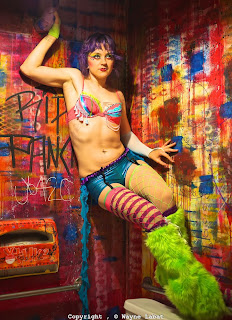I was hoping the Excalibur would be able to magically deal with this challenge. While it dealt with it better than the D3200, it seems that even a magic sword cannot defeat the devil on its' own. Ruby Room, we met again, and once again you kicked my photographic ass all around the ring. I was able to salvage a few shots, but I had to throw out way too many beautifully timed and framed shots that were just too blown to be salvageable. To give a clear visual of what I am talking about, compare these two images. This one is a completely off the cuff image shot when one of the performers dragged me into the ladies room to see the awesome wall background and climbed up onto the toilet to post. So, full spectrum light, all three colors for the camera to meter and record. Had to do very little post processing at all on this one, pretty much cropping and a bit of raw noise reduction.

Piece of cake for Excalibur. Now, contrast with the following shot. This one was one of the red wash shots that I was able to salvage. It took about half an hour of tweaking around playing with various levels and adjustments in Aperture to get it to the point it is here. I was able to save about 1 out of every 8 red wash shots, but from a practical workflow point of view, it's way too labor intensive to do, especially since way too often I would spend all the time on an image and still not be able to save anything useful.
So how to deal with this? Though the magic of google and a lot of reading I have come up with three possible solutions. The first one is the worst option in my opinion, but one I may have to wuss out and take on occasion if I really have to get a shot. Use a flash. kinda defeats the purpose of getting a badass low light picture taking machine, and it wrecks any cool effects of the lights. That can be somewhat mitigated by dialing the power wayyyyy down and just providing enough fill to balance the heavy red wash. I'll play with it sometime and see how it works. Second is a last ditch post processing technique. Found this one in a book I am reading in a discussion on when to use black and white versus color. One of the throwaway asides the author threw out was to try black and white if you have spent hours trying to get the color to work and just can't, but need want to save the shot. So, if you look at the whole album from this event, you will see several B&W conversions. Third, and the one I will really have to try out next time I face the Ruby Room head to head is recognize the single color cast, and respond by deliberately underexposing significantly from the sensor reading so the image won't get blown out and I can pull it up in post and get it back. I think this is the best option, the fun will come in trying to learn to calculate how much to underexpose and when, then get my reaction times fast enough to do it. Or maybe cheat and shoot autobracket and then just use a stack workflow. Finally, there is a fourth suggestion I found, that I really like, but isn't really viable long term- one photog who is just as bitter about this as I am suggested in jest that you could carry a slingshot or airsoft pistol in your camera bag and just shoot out all the red wash lights! As much as I like that idea, I think I will keep it in reserve until after I try the underexposure and flash plans, I have this thing about wanting to avoid jail time....
Otherwise, the gig was a good opportunity to experiment with some different settings and techniques for shooting fire. Took the ISO way down to 100, dialed the aperture in, dragged out the shutter and added a little rear curtain sync remote flash. Got some decent results, as you can see from the shots below, or in the full gallery
A few of the images had some ghosting instead of a clean flash capture. My theory is that this is because the Phottix Odin system lets me do remote TTL, so that is how I had the flash set up, and the system was trying to adjust and shoot this like a regular shot. Next time I will try taking the flash to manual and see if that gives better results. Still, pretty happy with how the experiment went overall.
So, while this wasn't my best night of shooting and I didn't wind up with too many useable images from the event, I was at least able to learn a lot and get a lot of ideas on where to go next. So overall a success. Now on to Lucidity Festival and a weekend straight of shooting- while also being the head aerialist rigger for the festival and doing the first family festival camp out with the Happy Dragon himself . Should be another fun filled, fast paced weekend filled with..... opportunities for learning!
.



I know the feeling and agree completely. Took time from editing to read this and wanted to support one of my dear friends and fellow photographers.
ReplyDeleteThanks! Loving the steampunk and fairie shots!
Delete